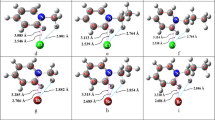Abstract
A calculation method previously used in the study of simple ion pairs is extended in the present work to the entropies of formation of copper(II) and zinc(II) complexes with polydentate ligands in aqueous solution. Not only a qualitative, but also a quantitative and more significant discussion of the entropy data seems possible by this method. In particular, if the literature entropy data for copper(II) complexes with some carboxylic ligands and for zinc(II) with polyamines are used, the change from 6 to 4 in the coordination number of the cation is demonstrated, in accordance with previous suggestions. In the complex(Zntren)2+, the metal shows a coordination number of 5, in agreement with previous X-ray results.
Zusammenfassung
Eine früher schon bei der Untersuchung einfacher Ionenpaare benutzte Berechnungsmethode wird auf die Entropiewerte der Bildung von Kupfer(II)- und Zink(II)-Komplexen mit Polydentat-Liganden in wässriger Lösung erweitert. Diese Methode scheint nicht nur eine qualitative, sondern auch eine quantitative und aussagekräftigere Diskussion der Entropiedaten zu ermöglichen. Ausgehend von Literaturangaben über die Entropie von Kupfer(II)-Komplexen mit einigen Carboxylgruppen enthaltenden Liganden und von Zink(II) mit Polyaminen wird, in Übereinstimmung mit früheren Annahmen, der Übergang von der 6-er in die 4-er Koordination demonstriert. Im Komplex (Zn tren)2+ ist die Koordinationszahl des Metalls 5, in Übereinstimmung mit früheren Röntgenergebnissen.
Резюме
Метод вычисления энт ропии, используемый р анее при изучении простых ионных пар, применен к случаю ком плексообразования двухвалентных меди и цинка с полифункцион альными лигандами в водном ра створе. Метод позволя ет проводить не только к ачественную, но и количественную инте рпретацию данных энт ропии. Используя литератур ные данные для комплексов меди с нек оторыми карбоксилсо держащими лигандами и для компл ексов цинка с полиаминами, показан о изменение координа ционного числа от 6 до 4, что наход ится в согласии с ранними предположен иями. В комплексе (Zn tren)2+ ме талл проявляет координац ионное число 5, что согласуется с дан ными рентгено-структ урного анализа.
Similar content being viewed by others
References
G. H. Nancollas, Interactions in Electrolyte Solutions, Elsevier, Amsterdam, 1966.
A. McAuley, G. H. Nancollas and K. Torrance, Inorg. Chem., 6 (1967) 136.
G. Degischer and G. H. Nancollas, J. Chem. Soc., A (1970) 1125.
M. Ciampolini, P. Paoletti and L. Sacconi, J. Chem. Soc. (1961) 2994.
J. W. Larson, J. Phys. Chem., 74 (1970) 3392.
R. Aruga, J. Inorg. Nucl. Chem., 36 (1974) 3779.
J. W. Cobble, J. Chem. Phys., 21 (1953) 1443, 1446.
K. B. Yatsimirskii, in Advances in the Chemistry of the Coordination Compounds, Macmillan, New York, 1961.
Selected Values of Chemical Thermodynamic Properties. National Bureau of Standards, Technical Notes, 270-3 (1968), 270-4 (1969), 270-5 (1971), 270-6 (1971), 270-7 (1973).
R. Aruga, J. Inorg. Nucl. Chem., 39 (1977) 2159.
V. S. K. Nair and G. H. Nancollas, J. Chem. Soc. (1961) 4367.
R. Aruga, Atti Accad. Scienze Torino, 111 (1976–77) 193.
W. M. Latimer, Oxidation Potentials, Prentice-Hall Englewood Cliffs, N. J., 1952.
W. M. Latimer and W. L. Jolly, J. Amer. Chem. Soc., 75 (1953) 1548.
See ref. 9, Tech. Note, 270-3 (1968).
G. Schwarzenbach, Helv. Chim. Acta, 33 (1950) 974.
L. Sacconi, P. Paoletti and M. Ciampolini, J. Chem. Soc. (1961) 5115.
I. Poulsen and J. Bjerrum, Acta Chem. Scand., 9 (1955) 1407.
M. Ciampolini, P. Paoletti and L. Sacconi, J. Chem. Soc. (1960) 4553.
P. M. Milyukov, Izv. Vyssh. Ucheb. Zaved., Khim. Khim. Teknol., 4 (1961) 212.
S. J. Ashcroft and C. T. Mortimer, Thermochemistry of Transition Metal Complexes, Academic Press, London, 1970.
E. L. Lippert and M. R. Truter, J. Chem. Soc. (1960) 4996.
Author information
Authors and Affiliations
Rights and permissions
About this article
Cite this article
Aruga, R. Quantitative thermodynamic evidence of transition from hexacoordinated to tetra- and pentacoordinated structures in aqueous copper(II) and zinc(II) complexes. Journal of Thermal Analysis 30, 1381–1386 (1985). https://doi.org/10.1007/BF01914310
Issue Date:
DOI: https://doi.org/10.1007/BF01914310




